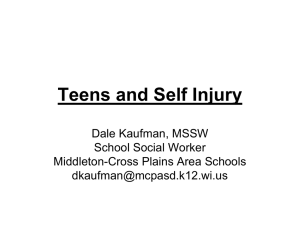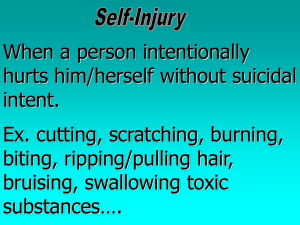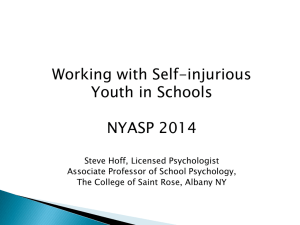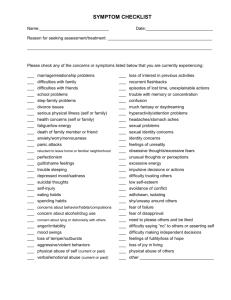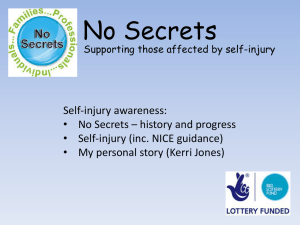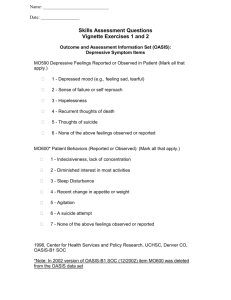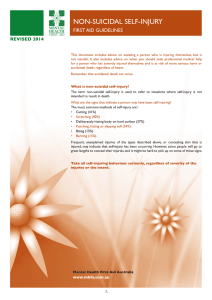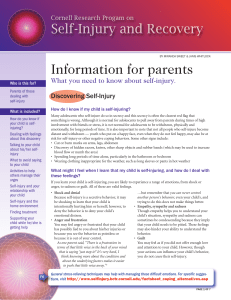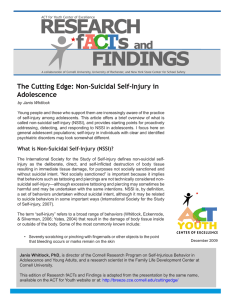Self Injury - School Mental Health
advertisement
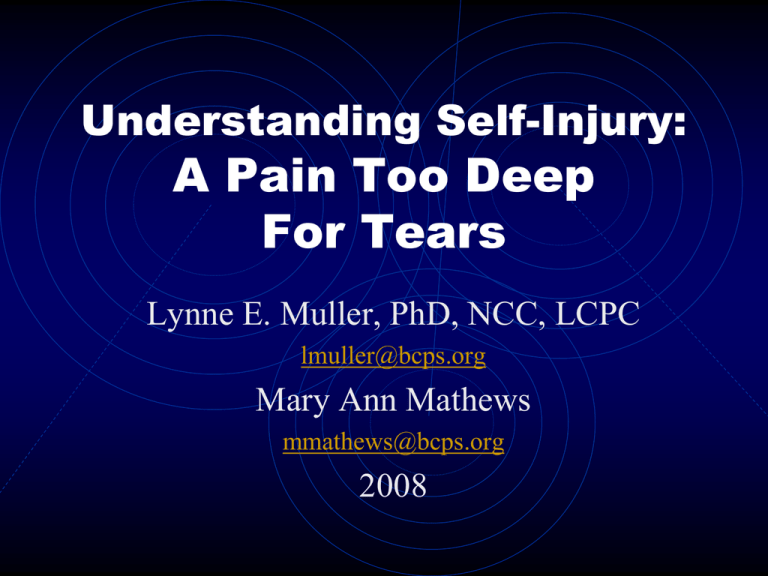
Understanding Self-Injury: A Pain Too Deep For Tears Lynne E. Muller, PhD, NCC, LCPC lmuller@bcps.org Mary Ann Mathews mmathews@bcps.org 2008 Self Injury 1. Who self injures? 2.Why do they do it? 3.What it is and is not. 4.How can we help? “I needed to cut the way your lungs scream for air when you swim the length of the pool underwater in one breath. It was a craving so organic it seemed to have risen from my skin itself.” Caroline Kettlewell Skin Game 1 Self-Injury Terms Self Inflicted Violence Cutting Self Harm Self Mutilation SI Behaviors • • • • • • • • • Cutting Scratching Abrading Burning Some forms of hair pulling Biting Inserting foreign objects into the body Interference with wound healing Ingesting toxins Warning signs • Unexplained frequent cuts or burns • Wearing long sleeves or pants in warm • • • • • weather Avoiding swimming pools or the beach Wearing thick bracelets to cover wrists Having sharp objects in purse, book bag, or bedroom Difficulty expressing feelings Withdrawal from close relationships Self injury is the intentional harm of one’s own body without conscious suicidal intent. (Aldeman, 1998, Favazza, 1998, van der Kolk, et al., 1991) What Self Injury is NOT • It is not a suicide attempt (attempting to feel better, not escape all feelings) • It is not usually attention seeking • It is not a danger signal to others NOT SUICIDAL BEHAVIOR • “…self-mutilation is distinct from suicide…A basic understanding is that a person who truly attempts suicide seeks to end all feelings where as a person who selfmutilates seeks to feel better.” (Favazza, 1998) • Intention-does not intend to die as a result of his/her acts. Intends to live. Who? • Roughly 2% (1-4%) of the population. In some studies reported as high as 8 million Americans self-mutilate. • 30 times the rate of suicide attempts • 140 times the rate of completed suicides • May also suffer from eating disorders • 90% who cut began as teenagers Who? • Typical profile • Female • Mid 20’s to early 30’s • Began cutting as a teen • Middle to upper class • Intelligent, well educated • Perfectionist Who? • Males and females • All races and socio-economic levels • Ages 15-50’s • Not easily identifiable Characteristics • are often depressed, feel powerless or • • • • • • • • • anxious have low self esteem /negative body image have difficulty expressing their emotions verbally experience difficulty with relationships aim for perfection often have negative body image lack impulse control/suppressed anger do not have a repertoire of coping skills may have serotonin dysfunction possible trauma Abuse? • Many who self-injure did not suffer childhood abuse (Zweg-Frank, et.al, 1995, Brodsky, et. al., 1998) • 50-60% suffered childhood abuse or trauma. That means that 40-50% did not (Favazza,1998) Then Why? • Invalidating environments (Lineham, 1993) • Expression of private experiences and feelings are not validated • Feelings are trivialized, punished or ignored • Experience of painful emotions are disregarded. • Child’s interpretation of his or her behavior is dismissed In their own words . . . 2&3 “There are times when I hurt too deep for tears, so I cut and it lets out some of the hurt. It’s like when you see the blood flowing out, the pain and fear are flowing with it.” “Watching the blood flow out makes me feel clean, purified. It feels like something bad or dirty is leaving with the blood.” In their own words . . . 4 “The stopped voice becomes a hand lifting knife, razor, broken glass to cut, burn, scrape, pop, gouge. The skin erupts in a mouth, tongue less, toothless. A voice drips out, liquid…a voice sears itself for a moment, in the flesh. This is a voice emerging on the skin, a mouth appearing on the skin. The body which could not be air on the larynx becomes the stroke of a razor on the breastbone or of a red-hot-knife-tip upon the wrist…” . Janice McLane (1996) Why do they harm themselves? • To release intense feelings • The physical pain may be easier to deal with than the emotional pain • To feel real, alive • To exert some control • Acting out self punishment Cycle of Cutting Cutting Disassociation Into the Void Panic Relief Shame, guilt, remorse, disgust Mounting anxiety, anger or self hatred, alienation Muller 2005 In their own words . . . 5&6 “It’s like opening up a safety valve or letting steam out of a covered pot.” “Sometimes I cut just to make myself feel something because I am just totally numb.” (In Strong, 1998, p.7) Why? 7 “I felt like I was isolated from the world, dead, with no emotions at all. The blood told me I was alive, that I could feel…Also I couldn’t cry, and bleeding was a different form of crying.” (Lindsay in Strong, p.57) What about the DSM? Currently listed as a symptom associated with a number of mental health disorders Some mental health professionals are advocating for self injury to be listed as a separate diagnosis SI is often associated with: • Borderline Personality Disorder • Obsessive-Compulsive Disorder • Post-Traumatic Stress Disorder • Dissociative Identity Disorder • Eating Disorders • Substance Abuse • Depression DIAGNOSIS (Ferreira de Castro, et.al., 1998) Self-Injure Suicide Attempt Major Depression 14% 56% Alcohol Dependence 16% 26% 2% 9% Dysthymia 12% 7% Adjustment disorder with depressed mood 24% 6% Schizophrenia Therapeutic Goals • Encourage communication about self- injury and relevant aspects of the child’s life. • Improve the quality of client’s life as it relates to self-injury. • Explore themes of guilt and shame. • Diminish use of self-injury as the coping skill when client desires to make changes. (Conners, Rubin, et, al,2002). Helping: What to Do (Alderman, 1997) • • • • • • • • Learn about self-injury. Talk about SI. Ask about it. Be supportive. Show you care. Acknowledge the effort to cope with very difficult emotions Set limits Be available, but refer when appropriate Don’t discourage self-injury Recognize the severity of the distress What Not to Do • Be afraid to ask the question, “Do you self• • • • injure?” Make eliminating the behavior the primary goal Make a safety contract or use contracts as a reward or punishment Visibly monitor their injuries Make him or her feel ashamed or guilty about the behavior “This is yet another secret I must hold to myself because my therapist has given me an ultimatum, either no more hurting myself or we will have to discontinue our therapy. So a little distance comes between us now, a secret that hold great importance which we could both learn from, if I was able to tell her…JML Interrupting the Cycle •Dispute irrational thoughts, feelings •Triggering event •Unbearable tension, anxiety •Dissociation •Self injury •Relapse Expressive Arts • Journals • Poetry • Music • Art •Self-Injury Group Respond to the following statements by writing “A” for “agree” if you mostly agree with the statement or “D” for “disagree” if you mostly disagree. Be ready to explain your responses. ___Self-injurers are survivors. ___Self-injurers are weak people. ___Self-injurers are harming themselves to get attention. ___Self-injurers are perfectionists. ___Self-injury is a type of suicidal behavior. ___Self-injurers are proud of their scars. ___Self-injury helps people cope. ___Self-injurers are more sensitive than most other people. Muller 2006 Self-Injury •If my wound could talk it would say_______________________________________________ __________________________________________________ ________________________________________________ __________________________________________________ _________________________________________________ __________________________________________________ __________________________________________________ __________________________________________________ __________________________________________________ Muller 2006 Taking Care of Yourself • Monitor your own horror and confusion • Broaden your perspective past the behavior to the intent behind it • Seek consultation • Get support for yourself Care and Concern • The capacity to derive comfort from another is the single biggest predictor of whether traumatized patients are able to give up their selfdestructive habits. (van der Kolk) Care and Concern • The development of a safe and trusting relationship is vital for the child to learn to sooth and care for him or herself in a healthy manner by internalizing their therapist’s care and concern. (Strong, 1988) Care and Concern 10 “_____ was the first to acknowledge that maybe I was in pain, as opposed to ‘doing it for attention’ . This affirmation of my inner pain was a healing force. “ Shelley Discussion • Why the upsurge in self-injurious behavior? • Students who look for fist fights? • Tattoos and piercing? • Addictive?

